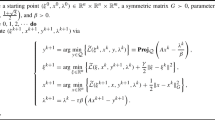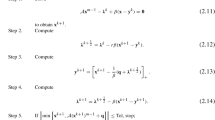Abstract
Subspace minimization conjugate gradient (SMCG) methods are a class of quite efficient iterative methods for unconstrained optimization and have received increasing attention recently. The search directions of SMCG methods are generated by minimizing an approximate model with the approximate matrix \(B_k\) over the two-dimensional subspace spanned by the current gradient \(g_k \) and the latest step. The main drawback of SMCG methods is that the parameter \(g_k^TB_kg_k \) in the search directions must be determined when calculating the search directions. The parameter \(g_k^TB_kg_k \) is crucial to SMCG methods and is difficult to be determined properly. An alternative solution for this drawback might be to exploit a new way to derive SMCG methods independent of \(g_k^TB_kg_k\). The projection technique has been used successfully to derive conjugate gradient directions such as the Dai–Kou conjugate gradient direction (Dai and Kou in SIAM J Optim 23(1):296–320, 2013). Motivated by the above two observations, we use a projection technique to derive a new SMCG method independent of \(g_k^TB_kg_k\). More specifically, we project the search direction of memoryless quasi-Newton method into the above two-dimensional subspace and derive a new search direction, which is proved to be descent. Remarkably, the proposed method without any line search enjoys the finite termination property for two-dimensional strictly convex quadratic functions. An adaptive scaling factor in the search direction is exploited based on the finite termination property. The proposed method does not need to determine the parameter \(g_k^TB_kg_k\) and can be regarded as an extension of the Dai–Kou conjugate gradient method. The global convergence of the proposed method is established under the suitable assumptions. Numerical comparisons on the 147 test functions from the CUTEst library indicate that the proposed method is very promising.













Similar content being viewed by others
Data Availability
The datasets generated during and/or analyzed during the current study are available from the corresponding author on reasonable request.
References
Andrei, N.: An accelerated subspace minimization three-term conjugate gradient algorithm for unconstrained optimization. Numer. Algorithms 65(4), 859–874 (2014). https://doi.org/10.1007/s11075-013-9718-7
Andrei, N.: Nonlinear Conjugate Gradient Methods for Unconstrained Optimization. Springer, Berlin (2020). https://doi.org/10.1007/978-3-030-42950-8
Dai, Y.H., Kou, C.X.: A Barzilai–Borwein conjugate gradient method. Sci. China Math. 59(8), 1511–1524 (2016). https://doi.org/10.1007/s11425-016-0279-2
Dai, Y.H., Kou, C.X.: A nonlinear conjugate gradient algorithm with an optimal property and an improved Wolfe line search. SIAM J. Optim. 23(1), 296–320 (2013). https://doi.org/10.1137/100813026
Dai, Y.H., Liao, L.Z.: New conjugacy conditions and related nonlinear conjugate gradient methods. Appl. Math. Optim. 43, 87–101 (2001). https://doi.org/10.1007/s002450010019
Dai, Y.H., Yuan, J.Y., Yuan, Y.X.: Modified two-point stepsize gradient methods for unconstrained optimization. Comput. Optim. Appl. 22(1), 103–109 (2002). https://doi.org/10.1023/A:1014838419611
Dai, Y.H., Yuan, Y.X.: A nonlinear conjugate gradient method with a strong global convergence property. SIAM J. Optim. 10(1), 177–182 (1999). https://doi.org/10.1137/S1052623497318992
Dolan, E.D., More, J.J.: Benchmarking optimization software with performance profiles. Math. Program. 91(2), 201–213 (2002). https://doi.org/10.1007/s101070100263
Fletcher, R., Reeves, C.: Function minimization by conjugate gradients. Comput. J. 7(2), 149–154 (1964). https://doi.org/10.1093/comjnl/7.2.149
Gould, N.I., Orban, D., Toint, P.L.: CUTEst: a constrained and unconstrained testing environment with safe threads for mathematical optimization. Comput. Optim. Appl. 60, 545–557 (2015). https://doi.org/10.1007/s10589-014-9687-3
Hager, W.W., Zhang, H.C.: Algorithm 851: CG_DESCENT, a conjugate gradient method with guaranteed descent. ACM Trans. Math. Softw. 32(1), 113–137 (2006). https://doi.org/10.1145/1132973.1132979
Hager, W.W., Zhang, H.C.: A new conjugate gradient method with guaranteed descent and an efficient line search. SIAM J. Optim. 16(1), 170–192 (2005). https://doi.org/10.1137/030601880
Hestenes, M.R., Stiefel, E.L.: Methods of conjugate gradients for solving linear systems. J. Res. Natl. Bur. Stand. 49(6), 409–436 (1952). https://doi.org/10.6028/JRES.049.044
Huang, Y.K., Dai, Y.H., Liu, X.W.: Equipping Barzilai–Borwein method with two dimensional quadratic termination property. SIAM J. Optim. 31(4), 3068–3096 (2021). https://doi.org/10.1137/21M1390785
Liu, H.W., Liu, Z.X.: An efficient Barzilai–Borwein conjugate gradient method for unconstrained optimization. J. Optim. Theory Appl. 180(3), 879–906 (2019). https://doi.org/10.1007/s10957-018-1393-3
Liu, Z.X., Liu, H.W., Dai, Y.H.: An improved Dai–Kou conjugate gradient algorithm for unconstrained optimization. Comput. Optim. Appl. 75(1), 145–167 (2020). https://doi.org/10.1007/s10589-019-00143-4
Perry J. M.: A class of conjugate gradient algorithms with a two-step variable-metric memory. Discussion, Center for Mathematical Studies in Economics and Management Sciences, Northwestern University, Chicago (1977). https://EconPapers.repec.org/RePEc:nwu:cmsems:269
Polak, E., Ribière, G.: Note sur la convergence de méthodes de directions conjugées. Rev. Francaise Informat. Recherche Opértionelle 3, 35–43 (1969)
Polyak, B.T.: The conjugate gradient method in extreme problems. USSR Comput. Math. Math. Phys. 9, 94–112 (1969). https://doi.org/10.1016/0041-5553(69)90035-4
Powell, M.J.D.: Nonconvex minimization calculations and the conjugate gradient method. In: Griffiths, D.F. (ed.) Numerical Analysis. Lecture Notes in Mathematics, vol. 1066, pp. 122–141. Springer, Berlin (1984). https://doi.org/10.1007/BFb0099521
Powell, M.J.D.: Restart procedures of the conjugate gradient method. Math. Program. 2, 241–254 (1977). https://doi.org/10.1007/BF01593790
Shanno, D.F.: On the convergence of a new conjugate gradient algorithm. SIAM J. Numer. Anal. 15, 1247–1257 (1978). https://doi.org/10.1137/0715085
Sun, W.M., Liu, H.W., Liu, Z.X.: A class of accelerated subspace minimization conjugate gradient methods. J. Optim. Theory Appl. 190(3), 811–840 (2021). https://doi.org/10.1007/s10957-021-01897-w
Wang, X.M., Li, C., Wang, J.H., et al.: Linear convergence of subgradient algorithm for convex feasibility on Riemannian manifolds. SIAM J. Optim. 25, 2334–2358 (2015). https://doi.org/10.1137/14099961X
Wang, X.M.: Subgradient algorithms on Riemannian manifolds of lower bounded curvatures. Optimization 67, 179–194 (2018). https://doi.org/10.1080/02331934.2017.1387548
Yang, Y.T., Chen, Y.T., Lu, Y.L.: A subspace conjugate gradient algorithm for large-scale unconstrained optimization. Numer. Algorithms 76(3), 813–828 (2017). https://doi.org/10.1007/s11075-017-0284-2
Yuan, Y.X.: A modified BFGS algorithm for unconstrained optimization. IMA J. Numer. Anal. 11(3), 325–332 (1991). https://doi.org/10.3390/math11061420
Yuan, Y.X., Stoer, J.: A subspace study on conjugate gradient algorithms. Z. Angew. Math. Mech. 75(1), 69–77 (1995). https://doi.org/10.1002/zamm.19950750118
Zhao, T., Liu, H.W., Liu, Z.X.: New subspace minimization conjugate gradient methods based on regularization model for unconstrained optimization. Numer. Algorithm 87(4), 1501–1534 (2021). https://doi.org/10.1007/s11075-020-01017-1
Acknowledgements
We would like to thank the associate editor and the anonymous referees for their valuable comments and suggestions. We also would like to thank Professor Yu-Hong Dai in Chinese Academy of Sciences for his valuable and insightful comments on this manuscript. This research is supported by National Science Foundation of China (No.12261019), Guizhou Provincial Science and Technology Projects (No. QHKJC-ZK[2022]YB084).
Author information
Authors and Affiliations
Corresponding author
Ethics declarations
Conflict of interest
The authors declare no competing interests.
Additional information
Communicated by Stefan Ulbrich.
Publisher's Note
Springer Nature remains neutral with regard to jurisdictional claims in published maps and institutional affiliations.
Rights and permissions
Springer Nature or its licensor (e.g. a society or other partner) holds exclusive rights to this article under a publishing agreement with the author(s) or other rightsholder(s); author self-archiving of the accepted manuscript version of this article is solely governed by the terms of such publishing agreement and applicable law.
About this article
Cite this article
Liu, Z., Ni, Y., Liu, H. et al. A New Subspace Minimization Conjugate Gradient Method for Unconstrained Minimization. J Optim Theory Appl 200, 820–851 (2024). https://doi.org/10.1007/s10957-023-02325-x
Accepted:
Published:
Issue Date:
DOI: https://doi.org/10.1007/s10957-023-02325-x
Keywords
- Conjugate gradient method
- Subspace minimization
- Memoryless quasi-Newton method
- Finite termination property
- Global convergence




